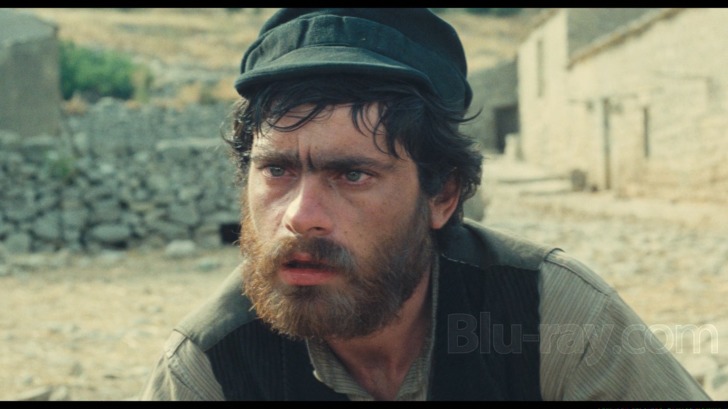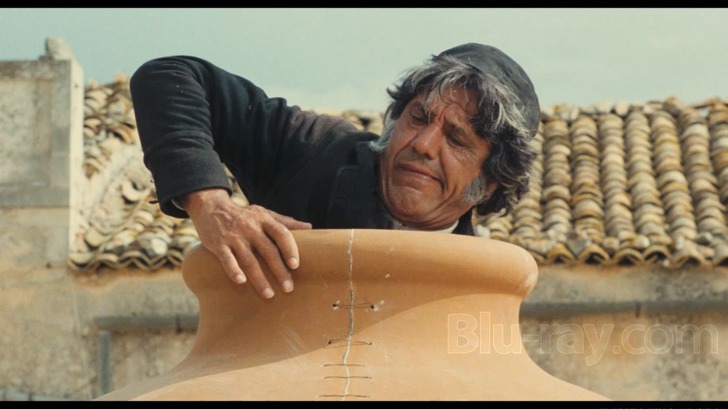Kaos Blu-ray Movie
HomeKaos Blu-ray Movie 
Cohen Media Group | 1984 | 188 min | Not rated | No Release Date
Price
Movie rating
7.3 | / 10 |
Blu-ray rating
| Users | 0.0 | |
| Reviewer | 3.5 | |
| Overall | 3.5 |
Overview
Kaos (1984)
Five stories set in turn-of-the-century Italy.
Starring: Margarita Lozano, Carlo Cartier, Salvatore Rossi, Franco Scaldati, Claudio BigagliDirector: Paolo Taviani, Vittorio Taviani
| Foreign | Uncertain |
| Drama | Uncertain |
| Romance | Uncertain |
| Comedy | Uncertain |
Specifications
Video
Video codec: MPEG-4 AVC
Video resolution: 1080p
Aspect ratio: 1.85:1
Original aspect ratio: 1.85:1
Audio
Italian: LPCM Mono (48kHz, 24-bit)
Subtitles
English
Discs
50GB Blu-ray Disc
Single disc (1 BD)
Playback
Region A (B, C untested)
Review
Rating summary
| Movie | 3.5 | |
| Video | 4.0 | |
| Audio | 4.0 | |
| Extras | 0.5 | |
| Overall | 3.5 |
Kaos Blu-ray Movie Review
Reviewed by Jeffrey Kauffman February 16, 2016Note: This film is available as part of
The Taviani Brothers Collection.
The history of Italian cinema in the post World War II era is a really fascinating subject, though one that often is traditionally shorthanded to
concentrate largely if not solely on neorealism. That now iconic genre, as evidenced by such legendary films as Rome, Open City, The
Earth Trembles, Bicycle Thieves and Umberto D. introduced (or at least reintroduced) global
audiences to such incredible filmmakers as Roberto Rossellini and Vittorio de Sica while also offering (especially American) audiences movies
that were in some ways diametrically opposite to the glossy, staged and often predictably formulaic entries that had tended to be part of
Hollywood’s studio system. (It’s interesting to note that the typically grittier film noir popped up in Hollywood at around the same
time as neorealism, something that might indicate a more universal attempt to bash through norms of presentation.) But while neorealism is
often used as a catch all into which some unlikely suspects are stuffed (like Federico Fellini, albeit for his less whimsical fifties work like La Strada), anyone who takes the time to pore over the huge gamut of films
which were produced and released in Italy even in the few years directly after World War II would have to admit that there was a lot more
going on than “just” neorealism. The sixties saw the rise of filmmakers (like Fellini, in fact) who pushed the stylistic envelope in ways that
the neorealists never would have, and as time and society moved on past the hardscrabble days of the late forties and early fifties, it’s at
least arguable that some elements of Italian cinema actually started to ply territory that was in fact closer to the glossy, staged and
predictably formulaic efforts that (at least once, and maybe continually) typified Hollywood. While a number of different genres or at least
cinematic niches popped up in Italy in the ensuing years, including giallo (Castle of Blood, included as an extra on Nightmare Castle, The Bird With the Crystal Plumage), perhaps
understandably Italian cinema became even more fragmented and varietal as the seventies gave way to the eighties. That may be one
reason
why the films of brothers Paolo and Vittorio Taviani can sometimes be hard to peg, at least accurately. The two are on record (including in
some lengthy interviews included as supplements on this new Blu-ray set) as stating that neorealism unavoidably played a part in their
cinematic upbringings, and therefore became a perhaps subliminal influence on their work, but there are other elements of the Tavianis’
oeuvre which don’t fit quite so neatly in that (or in fact any) preconceived category.

Many, maybe even most, Westerners tend to remember Luigi Pirandello (if they remember him at all, that is) as the playwright who gave the world one of its first entrés into the so-called “Theater of the Absurd”, Sei personaggi in cerca d'autore (Six Characters In Search of an Author). That’s an unfair proscription of a long, distinguished and Nobel Prize for Literature winning career, and it’s therefore instructive to note how far from absurdist tendencies Kaos (which is based on Pirandello stories) is, despite its seemingly disordered title. A portmanteau of sorts which uses a recurring image of a raven or crow with a bell tied around it neck to provide some questionably cohesive bridging material, Kaos offers a quintet of tales that are alternately heartrending, fantastic in an almost Felliniesque sense and/or whimsically humorous.
The rather disparate tones running throughout Kaos are perhaps appropriately hinted at by its very title, but it makes experiencing the film as a cogent, organically unified, work a bit hard to accept at times. The first story, “The Other Son”, deals with an elderly woman named Mariagrazia (Margarita Lozano) who has two sons who emigrated to America around a decade and a half previously. She has not heard from them in the interim, despite having sent several letters to them, letters she has to have another villager write for her since she’s illiterate. As is shown in the story’s opening scene, the “transcriber” is herself illiterate (something that’s unknown to Mariagrazia), and is simply scribbling doodles on paper, just the first of several potential heartbreaks this episode documents. The actual focus of the story turns out to be Mariagrazia’s third child, the titular “other”son, and a long estrangement which is detailed courtesy of a series of interstitial meanderings.
“Moonsickness” doesn’t quite skirt traditional giallo tropes, but it at least perhaps hints at some more gruesome tendencies in its tale of a young bride named Sidora (Enrica Maria Modugno) who begins to suspect her new husband Batà (Claudio Bigagli) may be a werewolf, or at least something similar, given to some rather feral behaviors when the moon waxes full. When a handsome man named Saro (Massimo Bonetti) enters the picture as a potential protector, a rather strange romantic triangle ensues.
The third story, “The Jar”, is the most unquestionably comedic of the tales in the film, as it follows an insanely huge piece of crockery which becomes damaged and needs repairing. A local land baron and attorney named Don Lollò (Ciccio Ingrasia, who bears a peculiar resemblance to Vincent Price) is the jar’s owner and he hires local craftsman Zi' Dima (Franco Franchi), who is famous for his jar repairing abilities due to his top secret glue recipe, to get the vessel back in shape to hold a rather undue amount of olive oil. Unfortunately Zi’ Dima ends up inside the urn, leading to some kind of surprising ruminations on class and economy.
The socioeconomic aspect is also front and center in “Requiem”, a kind of bittersweet saga which deals in various remnants of feudalism, with a bunch of farmers who have long worked a stretch of land owned by a local patrician. The workers want to actually bury their deceased brothers on this property rather than a distant cemetery in the nearest village, but the landowner (Pasquale Spadola) balks, leading to a class-privilege debate which is in some ways similar to the one espoused in “The Jar”, albeit from a decidedly less whimsical standpoint.
An “Epilog” featuring Luigi Pirandello (Omero Antonutti) himself is called “Conversing with Mother”, and in its formulation of a matriarch’s reminiscences may remind some of the Tavianis’ The Night of the Shooting Stars. While picturesque and actually kind of sweet, this episode brings the film to a close on a somewhat less fulsome emotional level than might have been optimal.
Kaos Blu-ray Movie, Video Quality 

Kaos is presented on Blu-ray courtesy of Cohen Film Collection with an AVC encoded 1080p transfer in 1.85:1. This is by and large a very winning looking transfer, one which preserves the sometimes startling burst of color in various segments while never straying too far from the kind of buttery, yellow tinged ambience that informs virtually the entire film. Detail is quite commendable in close-ups and the grain field resolves very naturally. There are a number of kind of peculiar anomalies that are noticeable, mostly in midrange and wide shots which lead me to believe there may have been a malfunctioning lens the Tavianis used for some shots (contrast screenshots 8 and 13 with some others in this review, and you'll note what almost looks like refraction or fringing around the edges of objects). These are transitory distractions in what is otherwise a natural looking presentation, one which certainly isn't glossy and "sharp" by contemporary standards, but which is artifact free and shows no signs of intrusive digital tweaking.
Kaos Blu-ray Movie, Audio Quality 

Kaos' LPCM mono track (in the original Italian, with optional English subtitles) is very much in line with the track on The Night of the Shooting Stars, offering a narrow but appealing rendering of the film's many outdoor sequences which present good opportunities for ambient environmental effects like the crow's plaintive cawing (along with the "neck bell" ringing). Dialogue is cleanly presented and well prioritized, and there are no problems with distortion, dropouts or other damage.
Kaos Blu-ray Movie, Special Features and Extras 

- Re-release Trailer (1080p; 1:34)
Kaos Blu-ray Movie, Overall Score and Recommendation 

Kaos occasionally plays like a miniseries and can be a bit of a slog to sit through at well over three hours of running time. While the writing of Pirandello provides an apparent linking mechanism, in truth the stories presented here are so disparate that it's hard at times to sense any through line. That said, the individual segments are largely quite winning and at least in some cases (notably "The Other Son") moving. Performances are excellent throughout and the Tavianis' proclivity of organically knitting people into their environment is very much alive and kicking throughout the various tales. Technical merits are generally strong (with one niggling exception in the video presentation, as outlined above), and Kaos comes Recommended.
Similar titles
Similar titles you might also like
(Still not reliable for this title)

The Night of the Shooting Stars
La notte di San Lorenzo
1982

Padre Padrone
Father and Master
1977

Bed and Board 4K
Domicile conjugal
1970

The Man Who Loved Women
L'homme qui aimait les femmes
1978

Pather Panchali 4K
পথের পাঁচালী / Song of the Little Road
1955

Betty Blue
37°2 le matin | Director's Cut
1986

El Sur
1983

Fox and His Friends
Faustrecht der Freiheit
1975

Le Combat dans l'île
Fire and Ice | Limited Edition
1962

Small Change
1976

I Vitelloni
1953

Le Havre
2011

The Voice of the Moon
La voce della luna
1990

Le Pont du Nord
1981

Amélie
Le fabuleux destin d'Amélie Poulain
2001

Amarcord
1973

Made in Hong Kong
Heung Gong jai jo / Xiang Gang zhi zao / 香港製造
1997

A Man Called Ove
En man som heter Ove
2015

Céline and Julie Go Boating
Céline et Julie vont en bateau: Phantom Ladies Over Paris
1974

A Lesson in Love
En lektion i kärlek
1954